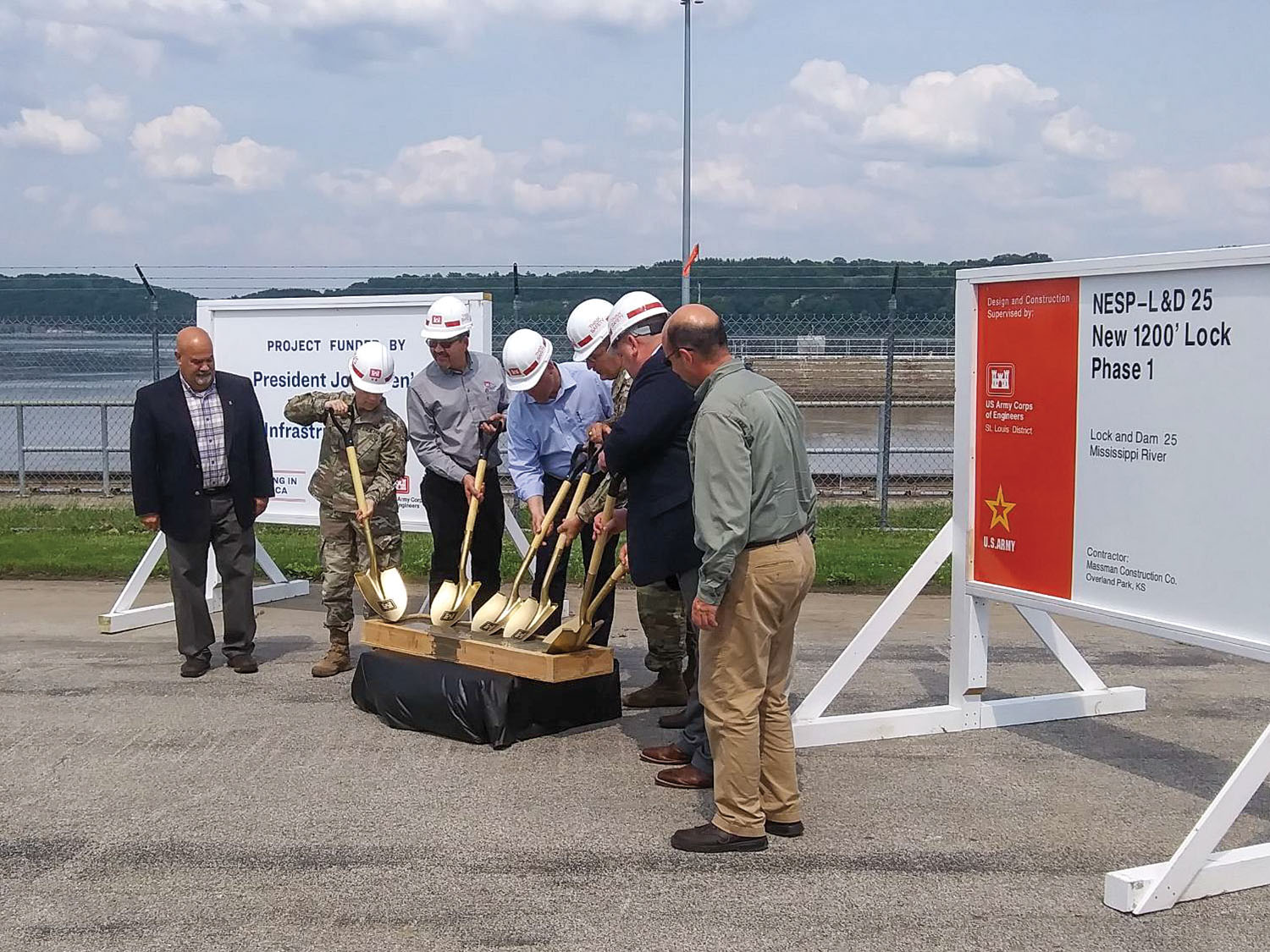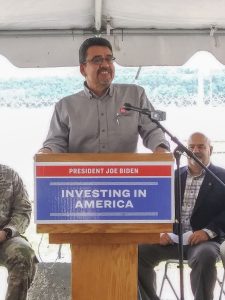Lock and Dam 25 Expansion Breaks Ground
View Source
A crowd of just under a hundred people attended the May 18 groundbreaking of an expanded 1,200-foot chamber at Lock and Dam 25 on the Mississippi River at Winfield, Mo., north of St. Louis. It was the culmination of a decades-long odyssey for many among the attendees, a generational event and a major milestone for the navigation industry and ag interests.
The speakers were introduced by Lou Dell’Orco, chief of operations, readiness and regulatory affairs at the St. Louis Engineer District, and represented all the groups and interests that have collaborated on the Navigation and Ecosystem Sustainability Program (NESP) over many decades.
Earlier that morning, the same group broke ground for a fish passage at Lock 22, further upriver at Saverton, Mo. Both projects were funded in the Infrastructure Investment and Jobs Act (IIJA) under the umbrella of NESP. The twin missions of NESP are navigation improvements and ecosystem improvement and restoration; the fish passage groundbreaking represented the latter mission, the Lock 25 event the former.
Phase 1
At Lock 25, a crane was busy preparing the riverbed for Phase 1 work, for which the lead contractor is Massman Construction Company. Phase 1 involves mostly preparatory work. Crews will focus on the river side of the existing 600-foot lock wall and modify it so that the structure can receive part of the new 1,200-foot chamber next to it. They also will add floating mooring bitts, kevels, line hooks and other equipment that barges need to move through.
Corps speakers included Col. Kevin Golinghorst, commander of the St. Louis Engineer District; Michael Connor, assistant secretary of the Army-civil works; and Maj. Gen. Diana Holland, outgoing commander of the Mississippi Valley Division of the Corps. Representing the navigation industry was Jeff Webb, president of Cargill Marine and vice chair of the executive committee of Waterways Council Inc., and Todd Behlke, vice president of vessel operations at Kirby Marine and co-chair of the River Industry Executive Task Force.

Drew Buntin, director of the Missouri Department of Natural Resources and a former chair of the Upper Mississippi River Basin Association, spoke just before Mitch Landrieu, President Biden’s infrastructure advisor and a former mayor of New Orleans and lieutenant governor of Louisiana. Buntin drew laughs when he noted that his department oversees a geology unit and said NESP’s progress didn’t look so slow in geological time scales. “But as in geology, all things are possible with time and pressure,” he said.
The addition of a 1,200-foot lock chamber at Lock 25 means that, when it’s completed, barge tows will no longer have to spend hours breaking and reforming tows to transit the lock. It’s the first of seven locks to be upgraded with the addition of 1,200-foot modern lock chambers, five on the Mississippi River and two on the Illinois River. Golinghorst spoke of soybeans from Iowa, Wisconsin, Illinois and Minnesota transiting the lock.
All the speakers spoke of offering thanks to “those on whose shoulders we all stand.” None attempted to name or list everyone who enabled this moment; it would have been impossible. Holland did ask, at one point, for all those attending who had worked on NESP to raise their hands; about a third of those present did so.
But speakers did single out two senators from Illinois for special thanks: Sen Dick Durbin (D-Ill.), who, as Senate Majority Whip when IIJA was being finalized, played a key role in getting NESP included; and Sen. Tammy Duckworth (D-Ill.), a member of several key committees including Commerce, Science and Transportation and Maritime, Freight and Ports, who helped shepherd the bill through the legislative process.
Long History
Congress formally authorized NESP in 2007, but its real history stretches back to Corps studies in 1989 and 1990 that addressed and evaluated ongoing problems in navigation, the congestion at the busiest locks, growing usage and an aging system. The Corps issued a feasibility report in 2004 that identified improvement projects, which Congress authorized. The study used a 50-year timeline running through 2050.
At the time, the Upper Mississippi River Basin Association and the U.S. Fish and Wildlife Service both stressed that the navigation study would set the future course for both commercial navigation and environmental integrity of the river system for years to come. “The resulting infrastructure investments will reaffirm the future of the river as a regulated pooled system. The significance of this decision cannot be overstated,” UMRBA said at the time.
Since 2004, the Corps has spent $65 million on technical studies and designs for 47 projects. Much of that money for studies was “reprogrammed” from general funds, preparing the way until such time as real funding for the larger projects became available.
The road to funding of NESP projects was long and winding. Lack of funding stopped NESP work altogether from 2011 through 2017. It wasn’t until the IIJA that meaningful NESP funding was pushed through by Congress, the culmination of much behind-the-scenes work by advocates.
NESP, which includes 1,000 projects large and small, will cost a currently estimated $7.9 billion over 50 years. Besides Buntin’s remark, the other line that drew good-natured laughter was Webb’s hope that the Lock 25 addition, with $732 million allocated, would be completed in two years.

